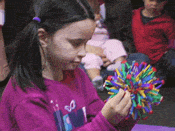Benefits: increases circulation and helps venous and lymphatic flow from the lower body; relieves swelling and fatigue in the legs; helps relieve muscular skeletal stress in pelvis; quiets the mind and can help promote ease in meditation and sleep.
Begin with using a double-folded blanket to be placed right above sacrum (see photo), setting it approx. distance 6-8" from wall (adjust in pose). Sit down on the blanket with one hip pressed right up against the wall. As you lower down, swing your legs up the wall. Once in the pose, you can adjust distance to wall, angle of legs to all, blanket and placement of legs all for comfort. Hips and tailbone will be in space between wall and blanket. Arms rest by your side, palms face up or variation with Goddess arms (photo above).
 The teacher or other supervising adult may lead the group or – something we like to do – encourage one of the kids to lead, establishing the breathing rhythm. As the leader slowly expands the sphere, all inhale deeply and slowly through the nose, from the belly. The leader then pauses, emulating the short, natural pause that happens at the “top” and “bottom” of each healthy breath. As the leader contracts the sphere, all exhale through the nose just as slowly.
The teacher or other supervising adult may lead the group or – something we like to do – encourage one of the kids to lead, establishing the breathing rhythm. As the leader slowly expands the sphere, all inhale deeply and slowly through the nose, from the belly. The leader then pauses, emulating the short, natural pause that happens at the “top” and “bottom” of each healthy breath. As the leader contracts the sphere, all exhale through the nose just as slowly.